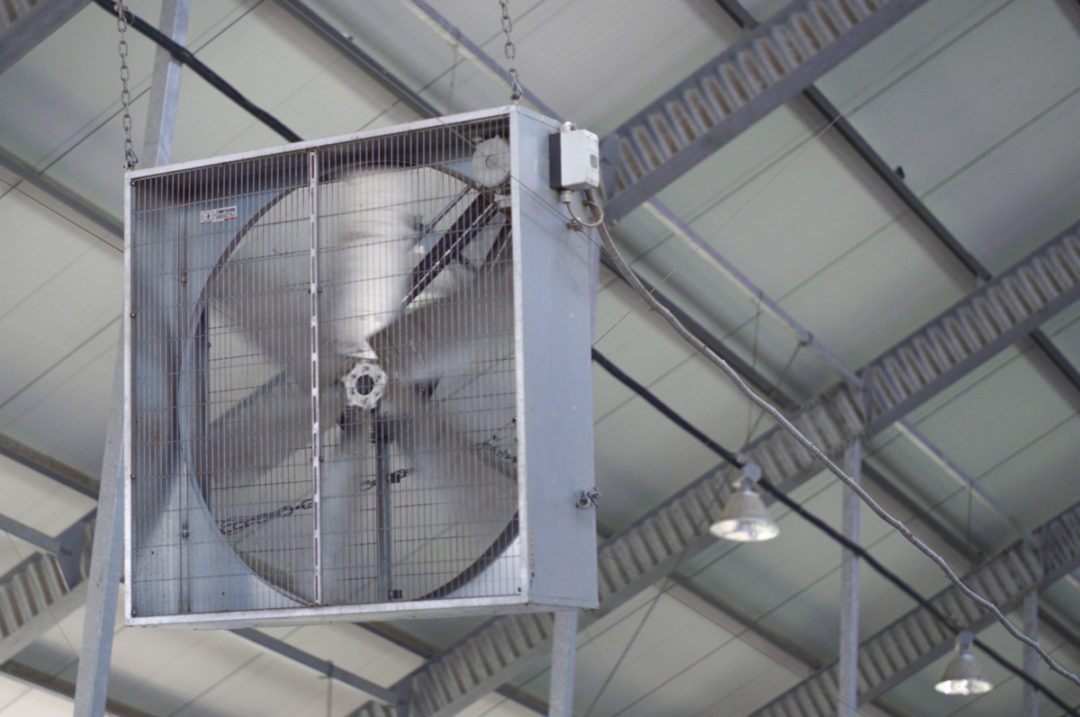As summer is now upon us, many dairy producers are thinking about fans. Maybe thinking about investing in fans for next summer, or maybe wishing they had purchased fans last year. However, just buying fans and hanging them haphazardly around your barn is not going to be very helpful in your fight against the rising summer temperatures.
When talking about ventilation for dairy facilities, there are a few key concepts that you need to consider to get it right, including assessing air speed and air exchange rates, confirming the system will work well in all climate conditions experienced in your area and ensuring the system works for all animals housed in the areas with the fans. It is important to take advantage of as much automation as possible on your farm. Focusing on these items can take your fans and turn them into a well-rounded and effective ventilation system.
When talking dairy barn ventilation, the air speed we are concerned about is the speed of the air traveling through the resting space of the cows. Air speed is the part of a ventilation system that is focused on cooling the cows. High air speed also has benefits when it comes to keeping flies under control and drying out bedding. While air speed can be calculated by taking the air flow through the cross-sectional area of the barn, it should also be measured using a handheld anemometer. Air speed is usually measured either in feet per minute (fpm) or meters per second (m/s). Target air speed varies depending on the weather conditions. In high-heat conditions, an air speed of 500 fpm (2.5 m/s) is recommended.
The air exchange rate is the rate at which dirty, humid air from inside the barn is replaced with clean, cool and fresh air from outside. The air exchange rate can either be measured in how many minutes or seconds it takes to completely exchange all the air in the barn, or it can also be displayed as air times per hour you are exchanging all the air inside your barn. So, if you had a 1-minute air exchange rate, that would be equal to 60 air changes per hour. The minimum air exchange rate in the coldest part of winter is recommended to be once every 15 minutes, or four times per hour. As temperatures increase, the rate at which the air is exchanged should also increase. Once we get to temperatures around 25°C (77°F) we should be targeting a 1-minute air exchange, or 60 air changes per hour.
It is important to note that a barn built in central Alberta will have a different ventilation system design than a barn for the same number of animals being built in north Florida. While air speed and air exchange targets do not change, how we achieve these targets will vary by climate. For example, the barn in central Alberta could face months of temperatures consistently below freezing, while northern Florida will hardly ever see temperatures in that range. This makes a significant impact on how we ventilate in the winter months. The reverse is true in the summer – central Alberta will see temperatures above 30°C (86°F) a few days in the year, while northern Florida can see daytime highs consistently above 30°C (86°F) for almost half the year. Again, we can see how climate conditions of the location of the barn will dictate how we go about achieving our ventilation targets. There is no cookie-cutter system that will work efficiently and effectively in all climates.
When we look at ventilation systems, it may seem like a foregone conclusion, but it is imperative that we design ventilation systems for the age and stage of the animals we are ventilating. A high-producing Holstein in her fourth lactation will have vastly different ventilation needs than a 3-day-old calf. The high-producing Holstein could be starting to feel the effects of heat stress at 18°C (65°F), but that 3-day-old calf will only be starting to enter its thermal neutral zone at that temperature. This also means that we cannot ventilate barns as a whole but must look at the different areas of the barn individually, as parts of a whole system.
The last key to getting the most out of your ventilation system is to automate it where possible. A climate control system will turn fans on or off based on the ambient conditions in the barn. It can also operate items like curtains, chimneys and even soaking systems. This ensures that you have a complete ventilation system working together and that the different components of the ventilation system are not fighting against each other. Relying on a farm hand to turn fans on when they feel hot, or when they have time, is just asking for trouble. As the cost of technology becomes cheaper and easier to use, the return on investment in automation becomes ever more attractive. With network-connected devices, many ventilation control systems are now also able to provide farmers with valuable information about the performance of their farm.
So don’t leave your ventilation up to chance. Use your fans to create a ventilation system that facilitates and creates the proper air speeds and air exchanges. Ensure that your ventilation system is designed appropriately for your climate. Before hanging fans, make sure you are going to ventilate the area appropriately for the animals housed there. Lastly, don’t overlook the value that automation can bring to your ventilation system. Combine all of these features, and you will be able to take some fans and turn them into a powerful and effective ventilation system.










